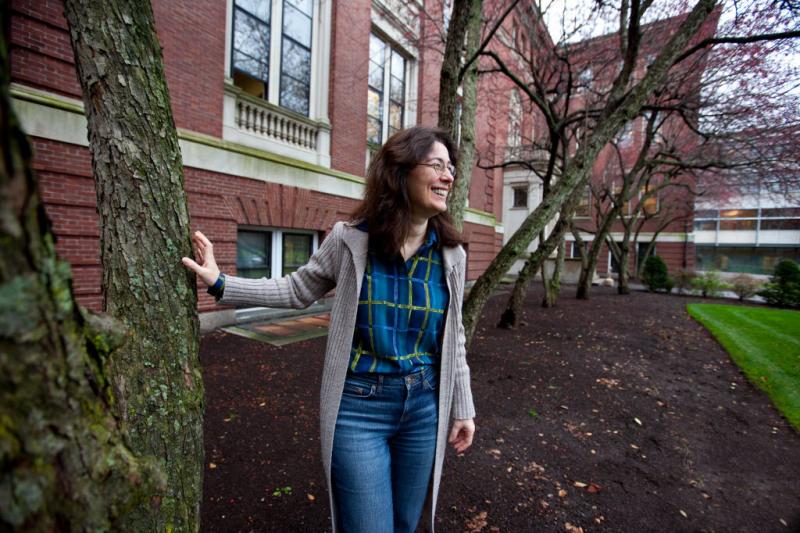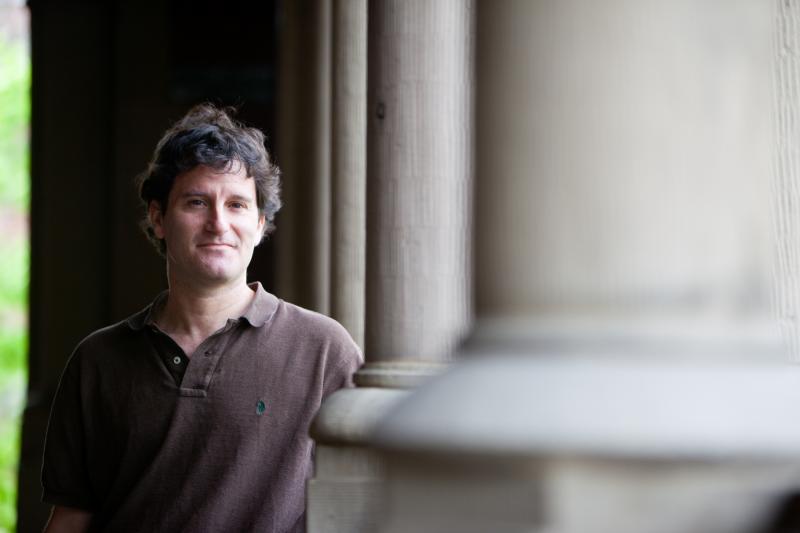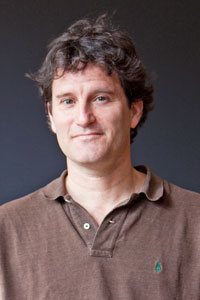News
Cambridge, Mass. – April 23, 2014 – Two leaders in materials science and applied mathematics from the Harvard School of Engineering and Applied Sciences (SEAS) have been elected fellows of the American Academy of Arts and Sciences.
Joanna Aizenberg, Amy Smith Berylson Professor of Materials Science, and Michael P. Brenner, Glover Professor of Applied Mathematics and Applied Physics, are among 204 new Academy members. The 2014 class includes some of the world’s most accomplished scholars, scientists, writers, artists, and civic, corporate, and philanthropic leaders.
Both Aizenberg and Brenner draw inspiration from nature in their research, blending structural insights from biology and physics with an engineer’s vision.

Joanna Aizenberg. (Photo by Rose Lincoln, Harvard Staff Photographer.)
Through her curiosity about the natural world, Joanna Aizenberg discovers the ‘design principles’ that allow biological organisms to adapt to their changing surroundings. In her research team, the glass structures within a sea sponge, the lens-covered skeleton of a brittlestar, and the slime on the top of a bacterial colony have all suggested new relationships between material structure and function.
Her recent achievements in materials synthesis have included the invention of the self-cleaning, self-healing Slippery Liquid-Infused Porous Surfaces (SLIPS), and SMARTS: active materials that automatically and reversibly change their physical structure in response to chemical signals, triggering new chemical reactions on cue.
Aizenberg currently leads a collaborative, 5-year project on bioinspired optics, through a Department of Defense Multidisciplinary University Research Initiative (MURI) sponsored by the Air Force Office of Scientific Research. With other experts from Harvard SEAS, MIT, Georgia Tech, the University of Exeter, and Scripps Institution of Oceanography, Aizenberg investigates how biological approaches to structural color can be adopted in technological platforms. For example, the same tricks beetles use to produce vibrant and metallic colors—or the ways cuttlefish signal to one another using rapid changes in color—could be recreated in the lab using new materials.
In addition to her role at SEAS, Aizenberg is a professor in the Department of Chemistry and Chemical Biology; director of the Kavli Institute for Bionano Science and Technology, which is based at SEAS; and a core faculty member of the Wyss Institute for Biologically Inspired Engineering at Harvard. She is a faculty associate of the Harvard University Center for the Environment (HUCE) and an affiliate of the BASF Advanced Research Initiative, based at SEAS. She also participates in Harvard’s Materials Research Science and Engineering Center (MRSEC).
Michael Brenner. (Photo by Rose Lincoln, Harvard Staff Photographer.)
Michael Brenner contributes to diverse areas of scholarship in the physical and biological sciences by identifying problems to which mathematics could provide a solution.
His research has quantitatively described phenomena like the breaking of fluid droplets, sonoluminescence, the sedimentation of small particles, microfluidics, the flow of water around whale flippers, and the movement of chemical plumes in the atmosphere.
Recently, he has tackled more biological questions, with engineering applications in mind. His work has explored the evolution of physiological systems like hemoglobin and voltage-gated ion channels, as well as the selectivity and transport mechanism of nuclear pores. Using advanced modeling techniques, he has also studied the growth of biofilms and yeast colonies, and the shapes of fungal spores.
In addition to his professorship at SEAS, Brenner is Area Dean for Applied Mathematics, a professor in the Department of Physics, a Harvard College Professor, a Kavli Scholar at the Kavli Institute, a faculty associate of HUCE, and a participant in Harvard’s MRSEC.
About the Academy fellows
Twenty-five members of the SEAS faculty are now fellows of the American Academy of Arts and Sciences—an indication of their expertise and diverse accomplishments.
One of the nation’s most prestigious honorary societies, the Academy is also a leading center for independent policy research. Members contribute to Academy publications and studies of science and technology policy, energy and global security, social policy and American institutions, and the humanities, arts, and education.
“It is a privilege to honor these men and women for their extraordinary individual accomplishments,” said Don Randel, Chair of the Academy’s Board of Directors, in a press release. “The knowledge and expertise of our members give the Academy a unique capacity—and responsibility—to provide practical policy solutions to the pressing challenges of the day. We look forward to engaging our new members in this work.”
The new class will be inducted at a ceremony on October 11, 2014, at the Academy’s headquarters in Cambridge, Massachusetts.
Since its founding in 1780, the Academy has elected leading “thinkers and doers” from each generation, including George Washington and Benjamin Franklin in the eighteenth century, Daniel Webster and Ralph Waldo Emerson in the nineteenth, and Margaret Meade and Martin Luther King, Jr. in the twentieth. The current membership includes more than 250 Nobel laureates and more than 60 Pulitzer Prize winners.
Topics: Awards, Applied Physics, Applied Mathematics
Cutting-edge science delivered direct to your inbox.
Join the Harvard SEAS mailing list.
Scientist Profiles
Michael P. Brenner
Michael F. Cronin Professor of Applied Mathematics and Applied Physics and Professor of Physics
Joanna Aizenberg
Amy Smith Berylson Professor of Materials Science and Professor of Chemistry & Chemical Biology






